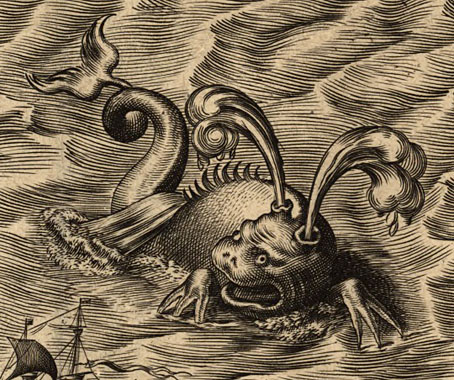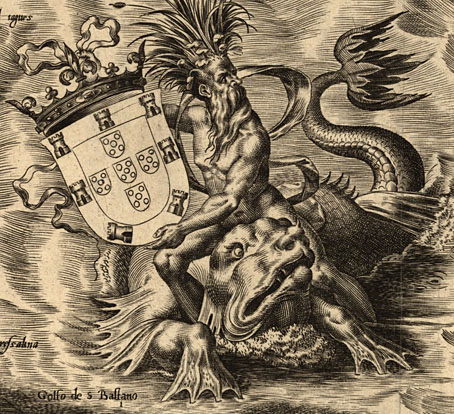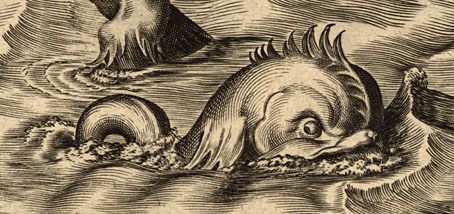When Herman Melville complains in chapter 55 of Moby Dick about erroneous representations of whales, this is the kind of thing he had in mind. Among those he takes to task, however, I don’t recall any of them having two blow-holes like the creature above.
The coat of arms of Portugal.
These fanciful beasts are the work of (no sniggering, please) Hieronymus Cock (1510–1570), an Antwerp engraver, and they populate the seas as part of his marvellous map of America created with the assistance of Spanish cartographer Diego Gutiérrez.
Gutiérrez’s magnificent 1562 map of America was not intended to be a scientifically or navigationally exacting document, although it was of large scale and remained the largest map of America for a century. It was, rather, a ceremonial map, a diplomatic map, as identified by the coats of arms proclaiming possession. Through the map, Spain proclaimed to the nations of Western Europe its American territory, clearly outlining its sphere of control, not by degrees, but with the appearance of a very broad line for the Tropic of Cancer clearly drawn on the map.
The map is described in detail here while another part of the Library of Congress Map Collections site has an incredible high-resolution copy which is a delight to pore over. This is a really big image (10492 x 11908 pixels) but the huge size is just what I love to see. You can not only zoom into the myriad details—cannibals cooking a human feast in Brazil—but also admire the precision of the cross-hatching. Less than forty years separate these generic creatures from Jan Saenredam’s far more accurate rendering of a beached sperm whale.
A dolphin (Melville classed dolphins and porpoises as small whales).
Elsewhere on { feuilleton }
• The etching and engraving archive
Previously on { feuilleton }
• Jan Saenredam’s whale
• The Whale again
• Rockwell Kent’s Moby Dick




No, I am sorry John, but that is exactly the sort of name to provoke sniggering.
Marvellous engravings however.
Hieronymus Cock, Moby Dick, sperm whales… There’s obviously a sub-text here.
Many are the glory holes where one may find hieronymous cock.
Hi John,
You might like this example of whale art from a tomb in Poland:
http://www.flickr.com/photos/castrovalva/3802938441/
Thanks Richard, that’s a great beast and you’ve spared me adding another comment to the burgeoning salaciousness. And in case anyone thinks it’s not very whale-like, Melville co-opts anything big enough into the class of whales, even arguing (unconvincingly) for the inclusion of the dragons.
I love these hybrid sea beasts, there is a good group of them by Andrea Maglioli (see google images), almost vegetable tails, muscular spiral bodies, front legs of a horse with great webbed feet and a variety of heads – stags, bulls, lions, elephants etc.
But to get back to the salaciousness, it seems that the cock is the focal point of the Matham print in your Saenredam whale post. It is central to the composition and is also being examined and used as a ladder.
Do you know the parody by Dominique Vivant, Baron de Denon, of these dead whale prints?.
It is an etching called “The Phenomenal Phallus” from his series “Priapic” 1793. It depicts a vast penis lying flaccid on a beach surrounded by small figures. ( I have it in a book, could not find it on internet)
Hi Paul. Those Maglioli prints are marvellous. Always fascinates me the way these rococo creatures seem to be floating across the water rather than swimming in it.
Not seen the Dominique-Vivant Denon, a shame there isn’t a decent version somewhere (one site has a very tiny image which may be it). Those stranded whales remind me of JG Ballard’s short story ‘The Drowned Giant’, in which the whale is replaced by an enormous human figure treated to the same degree of curiosity by the people who discover it.
YES! – I was going to mention the Ballard story, and then I went looking for the Vivant Denon picture and forgot,- I knew that there was something else that I was going to connect the whale and its penis to!
It was the line near the end of the story “As for the immense pizzle, this ends its days in the freak museum of a circus which travels up and down the north-west. This monumental apparatus, stunning in its proportions and sometime potency, occupies a complete booth to itself. The irony is that it is wrongly identified as that of a whale….”
And I found the Dominique – Vivant Denon …
http://www.evene.fr/boutique/index.php?idp=973&strs=erotisme&idoeuv=375024
Paul